




















The County of Santa Barbara Probation Department, established in 1909, serves the Courts and community by providing recommendations to the Court, enforcing Court orders, aiding victims and their families, and providing supportive services to individuals under supervision. Deputy Probation Officers (DPOs) and Juvenile Institutions Officers (JIOs) are peace officers who have the authority to arrest clients and youth under supervision. Arrests can occur if new law violations are committed, including violations of orders of the Court, or there is a failure to follow the conditions of probation, mandatory supervision, or Post Release Community Supervision (PRCS).
Through referral to and partnership with a variety of community-based resources, the Probation Department provides physical, emotional, behavioral and social services for both adult and juvenile clients under supervision countywide. The Probation Department also operates Probation Report and Resource Centers (PRRC) in both Santa Barbara and Santa Maria. These resource centers offer a welcoming environment for clients to attend evidence-based therapeutic sessions, life skills training, cognitive behavioral interventions, employment development, housing referrals, case management, and substance use interventions. The PRRCs also offer clients food, clothing, books, and access to computers.
02

otect and serve the community by:
roviding information and ecommendations to the Courts; roviding safe, secure, and effective uvenile detention and treatment rograms; nforcing Court orders and supervision nd release conditions requiring esponsibility/accountability, and upporting rehabilitation; and upporting victims of crime by facilitating eparation and restitution collection.
To promote justice and safety in the community through:
Delivering corrections services that are evidence-based, community-oriented, strength-based, and family-focused;
Guiding, motivating and directing those under supervision to take personal responsibility for their actions and facilitating case plans to support their success in the community;
Maintaining collaborative partnerships with the Courts, law enforcement, schools, and community service agencies;
Supporting victims by serving as an informational resource, establishing and collecting restitution, and providing balanced and restorative justice interventions for the community; and;
Encouraging active and informed community responses to crime.
POSITIVE WORK
ENVIRONMENT
Our employees are our greatest assets. The effectiveness of the Department is directly related to the extent to which all employees adhere to the following values: honesty, integrity, dedication, loyalty, teamwork, and ethical work performance These values are the foundation upon which we perform our duties and interact with one another, the Courts, those under supervision, realigned clients, partner agencies, and the general public. The following Organizational Values and Code of Ethics guide our efforts to serve and protect the citizens of Santa Barbara County:
COMPETENCY
We value and promote a positive work environment that:
LEADERSHIP
INNOVATION & FLEXIBILITY
PUBLIC RESOURCES
Protects the safety and welfare of employees, probationers, realigned clients, pretrial clients, youth and the general public; and Encourages initiative, productivity, creativity, teamwork and professional growth; and Stresses tolerance and is free of racial, ethnic, religious, and sexual harassment.
We value and promote the competency of all staff by:
Providing training to enable employees to effectively carry out their complex duties and individual responsibilities; Encouraging a variety of work experiences to enhance versatility, employee motivation, advancement, and opportunities for future professional growth; Providing employees with timely, balanced and objective assessments of their work performance; and Recognizing excellent work performance
We value and promote the development and demonstration of leadership by:
Recognizing leaders exist at all levels of the organization and encouraging the development and exercise of leadership skills; and
Acknowledging leadership is displayed through technical acumen, initiative, vision, decisiveness, and accountability extending beyond the immediate scope of responsibility; and
Recognizing leaders look for the bigger picture, influence beyond the boundaries of their immediate assignment, and think and act in terms of positive change; and
Acknowledging good leadership is objective, compassionate, understanding, and respectful of the dignity of others.
We value and promote innovation and flexibility within the organization by:
Seeking more effective, innovative, and evidence-based ways to deliver probation services within an ever-changing environment; Soliciting and considering feedback from consumers and staff, identifying and evaluating alternatives, and communicating outcomes and rationale prior to making formal organizational changes; and Planning and preparing for the implementation of organizational change in order to optimize results and cost effectiveness.
We value and promote the effective use of all public resources by:
Being accountable for providing all services in an efficient, cost-effective, and customer-focused manner within budgetary constraints; Utilizing current technology in order to provide the most effective service delivery; Implementing a robust program for the training and use of volunteers and student interns to reduce operational costs and enhance productivity; Encouraging volunteerism and community involvement by employees; and Collaborating with other government and community-based organizations.
In recognition of the profound responsibilities inherent in a profession dedicated to the adjustment of social relationships, Probation Department employees acknowledge these to be our guiding principles:
Serve with humility
Act without prejudice
Uphold the law with dignity
Be objective in the performance of my duties
Respect the inalienable rights of all persons
Maintain confidences entrusted to me
Cooperate with fellow workers and related agencies
Be aware of my responsibilities to the individual and to the community
Improve my professional standards through continuously seeking knowledge and understanding
Conduct my personal life with decorum
We accept these principles as our Code of Ethics and build our professional lives upon them.
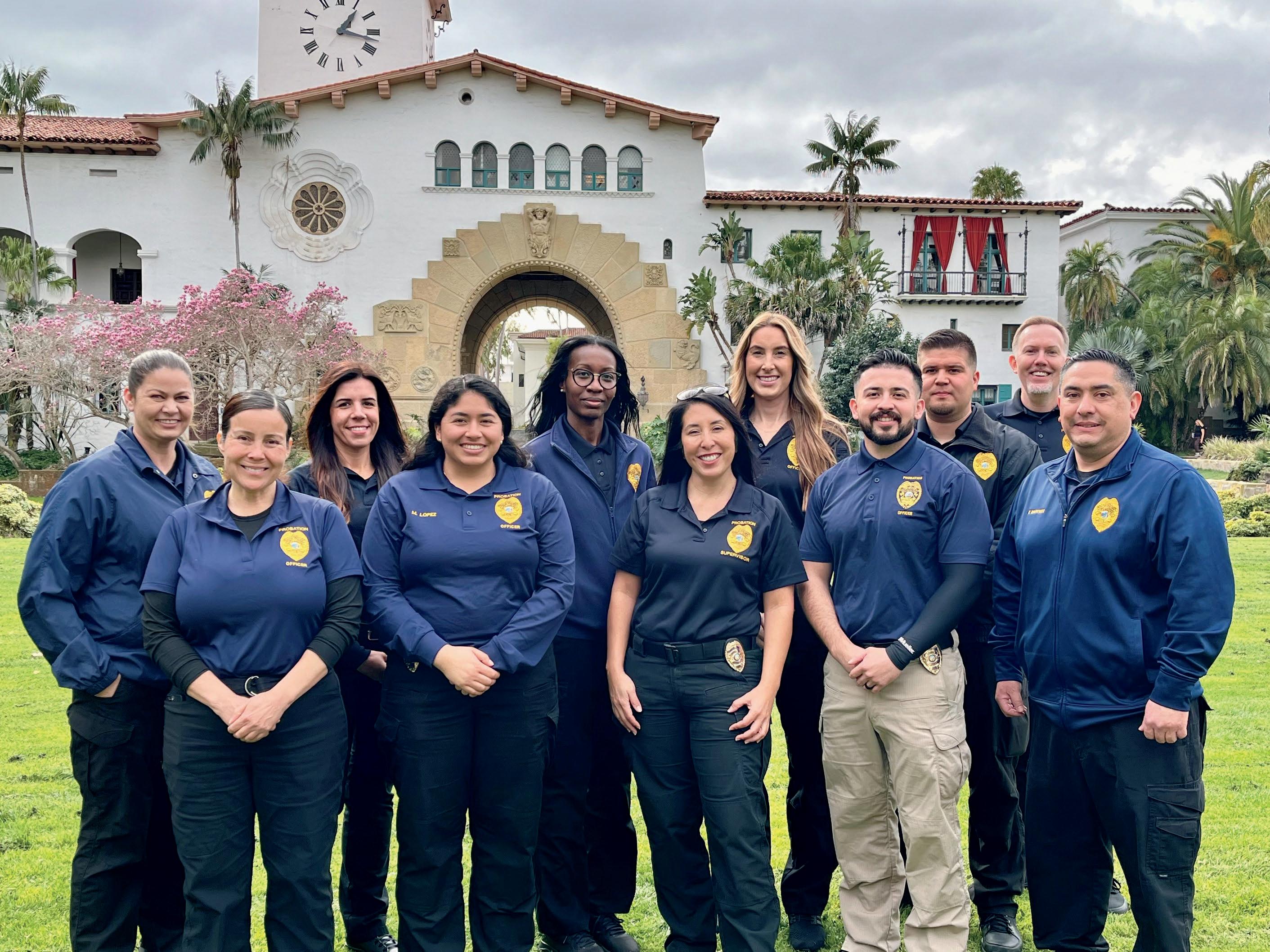

Holly L. Benton Chief Probation Officer




The Probation Department operates four (4) field service offices, two (2) Adult Probation Report and Resource Centers (PRRCs), and one (1) Juvenile Justice Center. The Administrative Office is located at 117 East Carrillo Street, Santa Barbara CA 93101. The Department’s Fiscal Year (FY) 2024-2025 operating budget funds 328 positions. The FY 2024-2025 adopted operating budget is $74,869,700.
Sixty-nine percent (69%) of the Department’s personnel are deputized and have peace officer powers (as of October 2024). The Chief Probation Officer has the overall responsibility for the Department and is selected by the judges of the Superior Court, following nomination by the Juvenile Justice Delinquency Prevention Commission, and appointed by the Presiding Judge of the Superior Court. There are three (3) sworn Deputy Chief Probation Officers; each is responsible for operations of a specific divisional and/or team area: Adult Services; Juvenile Services, and Juvenile Facilities. Fiscal, Revenue Recovery Unit, the Professional Standards Unit, Information Technology and support services are under the oversight of the Chief Financial and Administrative Officer.
The Probation Department’s workforce data is represented in Figures 1 and 2. The workforce data includes both sworn and non-sworn staff. Women make up 66% of the workforce, and men 34%. In terms of race and ethnicity, 4% of the Probation Department’s staff are Black; 52% are Hispanic; 38% are White; 1% American Indian/Alaskan Native; and 4% Asian.

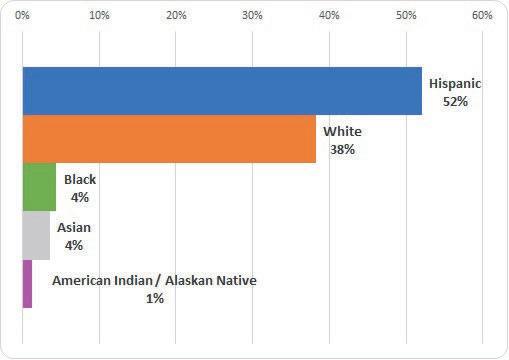
*Derived from the County of Santa Barbara 2021 Equal Employment Opportunity Plan (EEOP) https://countyofsb.sharepoint.com/sites/HR-Connect/SitePages/Diversity-Equity-and-Inclusion.aspx#census-dashboard
Adult & Juvenile Services
415 East Cypress Avenue Lompoc, CA 93436 (805) 737-7800

Administration, Adult and Juvenile Services
117 East Carrillo Street
Santa Barbara, CA 93101 (805) 882-3700
Probation Report & Resource Center (PRRC)
4500 Hollister Avenue
Santa Barbara, CA 93101
Juvenile: (805) 692-4840
PRRC: (805) 692-4890

Probation Report & Resource Center
124 Carmen Lane, Suite K Santa Maria, CA 93458 (805) 346-7620
Administration & Adult Services 2121 Centerpointe Parkway Santa Maria, CA 93455 (805) 803-8500
Juvenile Services
4251 California Boulevard Santa Maria, CA 93455 (805) 934-6366
Susan J. Gionfriddo Juvenile Justice Center (JJC) 4263 California Boulevard
Santa Maria, CA 93455 (805) 934-6270

BOARD OF SUPERVISORS
FIRST DISTRICT
SECOND DISTRICT
THIRD DISTRICT
FOURTH DISTRICT
FIFTH DISTRICT
Roy Lee
Laura Capps, Chair
Joan Hartmann
Bob Nelson, Vice Chair
Steve Lavagnino
LOMPOC
Honorable Stephen Foley
Commissioner Carol Hubner
SANTA BARBARA
Honorable Thomas Adams
Honorable Thomas Anderle
Honorable Clifford Anderson
Honorable Michael Carrozzo
Honorable Jean Dandona
Honorable Von Deroian - Assistant
Presiding Judge
Honorable Donna Geck
Honorable Pauline Maxwell
Honorable Raimundo Montes de Oca
Honorable Colleen Sterne
Commissioner Carol Hubner
SANTA MARIA
Honorable Jed Beebe
Honorable Stephen Dunkle
Honorable Denise Hippach
Honorable Kristy Imel
Honorable Patricia KellyPresiding Judge
Honorable Kay Kuns
Honorable Gustavo LavayenJuvenile Presiding Judge
Honorable John McGregor
Honorable Karen O’Neil
Honorable James Rigali
Gabriella Ferreira, Chair
Donna Tanney, Vice Chair
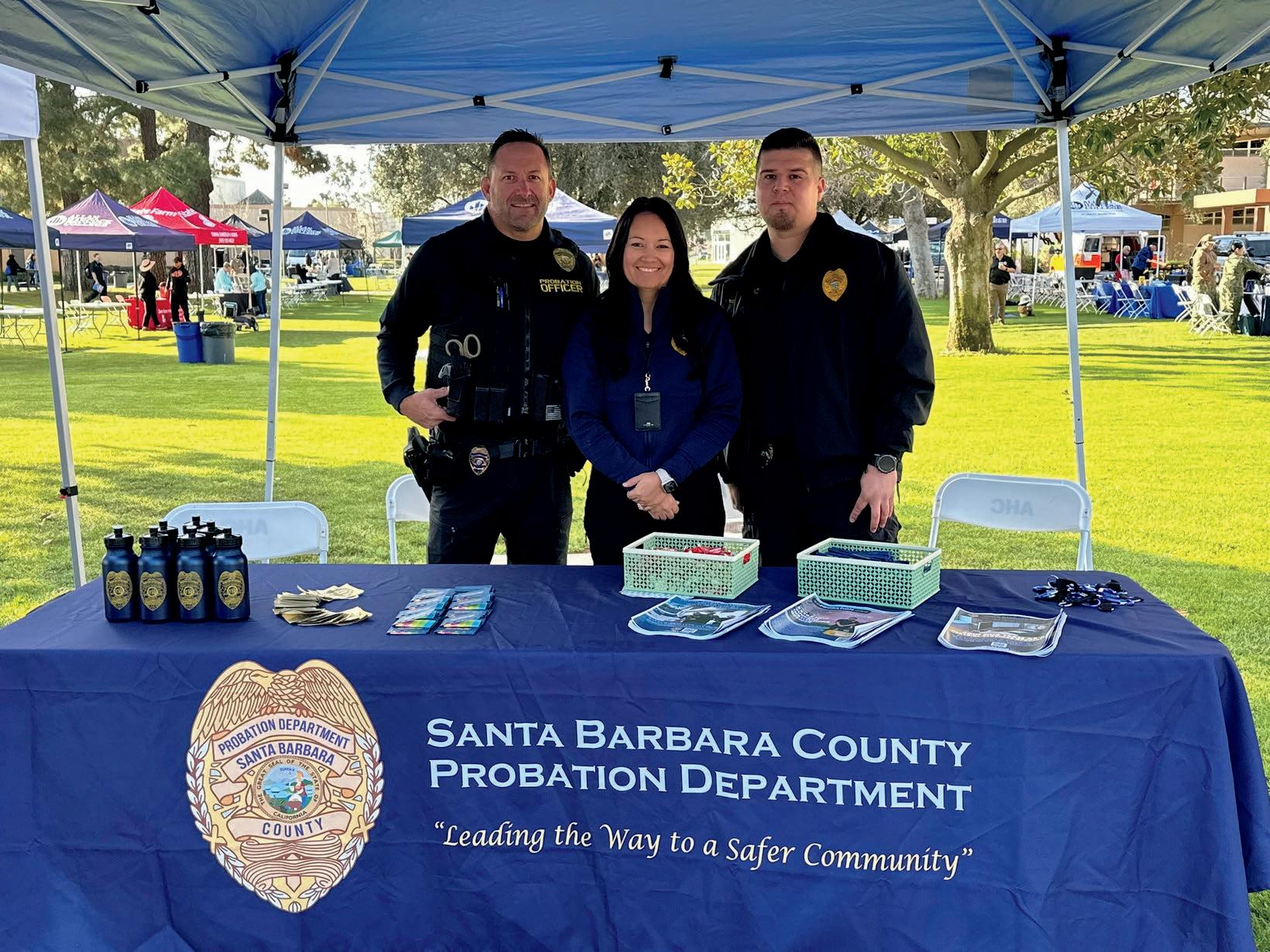
The Adult Services Division consists of pretrial assessment and monitoring, pre-plea and presentence investigation, field supervision services, and operation of two Probation Report and Resource Centers (PRRCs). Utilizing a risk, needs, and responsivity model approach, while using evidence-based tools, staff assess risk and needs and develop case plans that drive case management and the coordination and access to treatment, employment services, housing, and cognitive behavioral interventions to individuals while in the community under supervision Services include: electronic monitoring through GPS and remote alcohol monitoring; various collaborative courts; jail discharge planning; cognitive behavioral treatment interventions delivered through the PRRCs; Community Response Teams; Pretrial Assessment and Pre-Arraignment Release screening; Intensive Pretrial Supervision and the services of Pretrial Services Navigators; alternative sentencing supervision; housing assistance; and specialized caseloads and services for individuals with behavioral health challenges and those convicted of sex offenses, gang related crimes, and domestic violence. Through the above services and programs, the Adult Division provides services to clients from their initial arrest, case disposition, and supervision to provide the greatest possibility of a successful outcome. This is further illustrated in the detailed descriptions in the following pages.
The collaborative efforts of Deputy Probation Officers (DPOs) assigned as Jail Assessors and the Santa Barbara Sheriff’s Office (SBSO) Alternative Sentencing (AS) personnel ensure risk assessments are completed for clients applying for release on Electronic Monitoring (EM) in lieu of incarceration. The risk assessments are scored through the use of evidence-based screening and assessment tools. These scores assist in identifying clients to determine eligibility for alternative detention and programming. In addition to assessing clients, Jail Assessors also play a role in determining suitable
alternative sentencing methods and programs within the correctional facility They contribute to the referral process for the Discharge Planning Team and re-entry services. They are involved in the first step of re-entry planning and coordination which includes assigning a discharge planner, receiving and processing discharge planning referrals, and a variety of other assigned tasks. Jail Assessors also review parole and Post Release Community Supervision (PRCS) revocations with clients and act as liaisons to Probation, assisting clients who require or wish to utilize the Access Line for drug/alcohol treatment after their release from custody. The jail assessors are also tasked with attorney requests- specifically, the collection of signatures on releases of information and other legal documents-Probation requests, Parole holds and other requests.
On July 1, 2022, the Probation Department and the SBSO began a collaborative effort to monitor eligible individuals serving their Court ordered custodial commitments via Electronic Monitoring (EM) in lieu of incarceration. Each agency has committed to a shared responsibility to ensure the effective and safe monitoring of individuals on AS in the community. The SBSO continues to accept all AS applications, determine eligibility, and book/receive individuals prior to referring to Probation to begin the supervision portion of the commitment. Probation supervises these individuals in the community and, as applicable, provides assessment of the individual’s needs using an evidencebased assessment and subsequently provides referrals to community-based programs, monitors GPS tracks, conducts office appointments, makes field contacts, refers to appropriate community-based organizations for drug and alcohol services and drug tests individuals as needed.
The Probation Department has two Pretrial Assessment Units staffed by Pretrial Services Specialists (PTSS) who author pretrial reports for the Superior Court. PTSS work within the county jails and are the first point of contact to the pretrial process for clients who are booked into custody.

The PTSS use a validated pretrial risk assessment tool, the Virginia Pretrial Risk Assessment Instrument Revised (VPRAI-R), to assess an individual's success on pretrial release. Recommendations, based on the risk assessment with an overlay of suitability due to public safety considerations, include releasing the client on their own recognizance, onto pretrial supervision, or in some instances, for the client to remain detained Completed reports are submitted to the Courts and criminal court partners the evening before a client is arraigned so that all parties present at arraignment have the information needed to facilitate a streamlined court hearing process. In some instances, completed reports are submitted to on-call magistrates prior to arraignment to allow eligible clients pre-arraignment release either on their own recognizance or pretrial supervision.

The Probation Department Pretrial Supervision Units, c Pretrial Compliance Office tasked with providing direc to clients released by the C supervised pretrial release supervision efforts differ fr probation supervision, as p are presumed innocent as trial. Contemporary pretria suggest that clients be sup the least restrictive terms o possible to safeguard publ primary component of supervision efforts is to ensure pretrial clients attend all scheduled court hearings, as the ultimate goal is for their cases to successfully conclude, either by dismissal or sentencing. As their cases progress through the justice process, Pretrial Compliance Officers refer clients to appropriate services, conduct home and office visits as needed, and assist with ensuring they appear at upcoming court hearings.
The Probation Department contracts with Good Samaritan Shelters to staff four (4) Pretrial Service Navigators (PSNs) and two (2) Community Service Navigators (CSNs) who have similar roles, though work with different client types.
The primary role of a PSN is to assist clients placed on pretrial supervision who have vulnerabilities such as mental health needs, substance use issues, and homelessness. PSNs initiate contact with high-need individuals early in the criminal justice process, attend court hearings with the client, provide transportation to appointments or obtain medication, and coordinate services to facilitate the client’s success while on pretrial supervision
The CSNs provide case management and supportive services to assist high-risk clients under the Probation Department's supervision who are not on pretrial supervision. This target population may face a range of vulnerabilities such as mental health issues, housing instability, or substance use concerns.
Both CSNs and PSNs collaborate closely with discharge planning teams at local jails to ensure individuals identified with vulnerabilities experience a seamless transition into the community. This coordinated approach aims to provide a supportive handoff by connecting clients to resources that will enhance their successful reintegration into the community.
A Discharge Planning Team comprised of personnel from SBSO and the Probation Department, along with the Public Defender’s Rehabilitation Services Coordinators and a community-based representative, coordinate re-entry services at the jail These services include, but are not limited to: residential/sober living program screening; coordination with Santa Barbara County Department of Social Services for application/reinstatement for Medi-Cal referrals/linkage with mental health and/or public health; referral to, and coordination with, Collaborative Courts including Restorative Court, Veterans Treatment Court (VTC), Substance Abuse Treatment Court (SATC), and Mental Health Treatment Court (MHTC); and aftercare coordination with DPOs who monitor the clients upon release.
The target population continues to be all clients exiting the jail for whom assistance is requested. The level and extent of assistance is based on the individual’s health and social needs through cross-sector collaboration and coordination of pre-release planning Referrals are received from a variety of sources, including the client, family members and defense counsel. In line with the Disability Rights of California (DRC) Stipulated Agreement, efforts have been put in place to also ensure a subset of clients entering the jail receive discharge planning services; specifically, those identified by SBSO as Severe Mental Illness (SMI), residing in a Behavioral Health Unit (BHU), Chronic Care (hypertension) and Medicated Assisted Treatment (MAT) clients.
Adult Court Services provides criminal investigation information to the Superior Courts, District Attorney’s Office, and defense attorneys via reports authored by Deputy Probation Officers (DPO). Reports are provided in a number of formats, including Pre-Sentence reports for clients who have pled guilty or no-contest, or been found guilty either by a jury or Court trial; Pre-Plea reports, for those who are awaiting judgment; and Post Sentence reports on those who have been sentenced to state prison.
Pre-Sentence and Pre-Plea reports are comprehensive and include client psycho-social information, as well as statements from the victim, restitution information, and sentencing considerations. Sentencing considerations vary in complexity, ranging from single offense cases in which a client has been convicted and a disposition negotiated between the attorneys, to multiple count matters in which the client is presumed innocent, and the Probation Department must analyze the case as if guilt would be found on all counts. PrePlea reports are typically requested to provide all parties a preview of sentencing considerations. Recommendations on Pre-Sentence and Pre-Plea reports range from grants of probation, prison

The Probation Report and Resource Centers (PRRCs) are a day report and resource center for adult clients in Santa Barbara County The centers, located in Santa Barbara and Santa Maria, provide alternative interventions while offering clients evidence-based therapeutic interventions and life skills training to promote and support success in the community. PRRC programming focuses on, but is not limited to, cognitive behavioral interventions, employment development, housing referrals, case management, and substance use intervention referrals Clients referred to the PRRC receive early release monitoring, programming, and re-entry services as they transition from the custodial environment to the community. Clients are assessed using a validated risk and needs assessment instrument, the results of which, in conjunction with the client’s probation terms and conditions, are considered in developing a case plan tailored to the client As determined by the client’s risk to reoffend, and the case plan, clients may attend the PRRC up to five (5) days per week.
commitments served in county jail, a combination of a county jail prison term followed by a period of mandatory supervision by the Probation Department, and most seriously, state prison commitments, which could entail a life sentence. Probation Officers assigned to Adult Court Services undergo specific training annually in determinate sentencing and caselaw to maintain their competency and high caliber of written reports to the Superior Courts of Santa Barbara.
To support the rehabilitation of adults released onto probation supervision, clients are often required to participate in various programs including those to support sobriety, cognitive behavior therapy, counseling, vocational training, and job placement programs. The DPO refers individuals to evidence-based programs and closely monitors their attendance. Probation supervision includes contacting individuals at home, work, or in the community, conducting drug tests, and for clients whose probation terms allow, searching personal property for contraband. Restitution payments ordered by the Court are also monitored by Probation.
An "evidencebased" program offers a high level of research on effectiveness determined as a result of rigorous evaluations.
The level of supervision assigned to each client is determined by their assessed risk of reoffending and criminogenic needs as determined through a validated risk and need assessment tool, COMPAS. Case plans are developed to support clients in achieving milestones and ensuring their success, with those assessing as the highest risk to reoffend receiving the most intensive supervision, including the use of monitoring tools like Global Positioning System (GPS) or Secure Continuous Remote Alcohol Monitoring (SCRAM).
The Probation Department combines supervision services with specialized programs such as SATC, MHTC, or VTC, as well as charge specific caseloads, such as those for domestic violence (DV) or sex offenses to oversee adult clients. Furthermore, under the 2011 Public Safety Realignment Act (AB109), specialized caseloads have been established to supervise the realigned felony population.
The County's Public Safety Realignment Plan is available on the Probation Department website at www.sbprobation.org under Boards and Committees, Community Corrections Partnership (CCP).
Under Assembly Bill (AB) 109, the 2011 Public Safety Realignment Act expanded the county's jurisdiction to include PRCS and Post-Sentence Supervision (PSS). PRCS refers to individuals released from prison to local supervision after serving a felony commitment for a non-violent, non-serious and non-high-risk sex offense. Mandatory Supervision is also referred to locally as PSS; these are individuals sentenced pursuant to 1170(h)(5)(B)PC who qualify to serve their prison sentences locally in the County jail after being convicted of a nonserious, non-violent offense Additionally, these individuals are not registered sex offenders and do not have a prior “strike” (serious and/or violent felony conviction). The law allows for two (2) types of sentences; a commitment to County jail pursuant to 1170(h)(5)(A) PC or the aforementioned split sentence pursuant to 1170(h)(5)(B) PC, which includes a period of time in jail followed by a period on PSS by Probation.
PRCS and PSS cases are supervised with an enhanced client-to-officer ratio. A COMPAS risk and needs assessment and case plan are completed. Referrals to programs are initiated based on the criminogenic needs identified, including referral to the PRRC, GPS, or other specialty programming. These programs help individuals navigate the challenges they may face post-release, such as finding employment, securing stable housing, and addressing any other acute or criminogenic needs
Since March 1996, the Probation Department, the Santa Barbara County Superior Court, and the offices of the District Attorney (DA) and Public Defender (PD) have served clients with substance use issues on a specific court calendar, referred to as SATC.

The target population for Post-Plea SATC is high-risk/high needs, misdemeanor or felony clients who suffer from substance use disorder, and the goal is to reduce recidivism and substance use among non-violent clients by using evidence-based practices including early, continuous, and judicially supervised treatments; mandatory periodic drug testing; and graduated rewards and interventions. This program relies upon countywide networking and cooperation of county agencies and CommunityBased Organizations (CBOs) for support and success.
Once charges are filed against an individual, and if the client is eligible and chooses to participate, they enter a highly structured treatment program lasting between 12-18 months. Upon successful completion of the program, charges are dismissed. Conversely, prosecution is reinstated if the client fails to attend the program or if urine testing repeatedly indicates the client is using drugs or alcohol.
In 2017, a Pre-Plea SATC track was implemented to serve low-risk/high-needs clients. This program also utilizes evidenced-based practices and offers a less intensive 6month drug court program that is effective and cost-beneficial to medium-low risk misdemeanants or first-time felony clients with a limited criminal history. Should clients fail to attend a program or repeatedly test positive for drugs and alcohol, they will have a hearing to be removed from the program and enter a plea to proceed with criminal proceedings.
The DDX Court was developed to address the specific needs of a population of highrisk misdemeanor and felony clients experiencing co-occurring disorders of mental illness coupled with substance use. The DDX program follows the SATC model and is enhanced by supportive collaboration from the Probation Department, Behavioral Wellness (BWell), and local CBOs. This specialty court allows for a higher level of service, which includes more intensive interaction with clients in an effort to deter future criminal behavior and incarceration.
The Post-Plea MHTC is a 12 to 18-month program, which can be inclusive of six (6) months or more of care for clients who have been diagnosed and are currently suffering from a serious and persistent mental illness. Collaboration among the Court, Probation, DA, PD, BWell, and CBOs provide referrals and recommendations to serve this high-risk population
The VTC is a collaboration involving the Court, Probation, BWell, CBOs, and the U.S. Department of Veteran Affairs (VA) VTC serves the highest-risk veterans with substance dependency and/or mental illness who are charged with non-violent criminal conduct. The VTC acknowledges veterans' contributions and caters to their unique needs through locally-based VA treatment options, veteran organizations, and a Veteran Mentor Program. The program uses evidence-based screening and assessment tools to connect veterans with appropriate services, reduce incarceration rates, and assist with successful reintegration into the community
VTC is a post-plea program that utilizes the SATC treatment team approach to case management. VTC also provides a Pre-Plea Diversion track for veterans charged with a misdemeanor offense and who meet eligibility criteria under §1001.80 PC. Upon successful completion of this program, which can range from six (6) months to two (2) years in duration, charges are dismissed Unsuccessful completion results in the reinstatement of criminal proceedings.
Clients who have committed a sex offense receive supervision from the Adult Special Programs Unit. They are subject to specialized monitoring using three (3) stateate t he a or p ed "

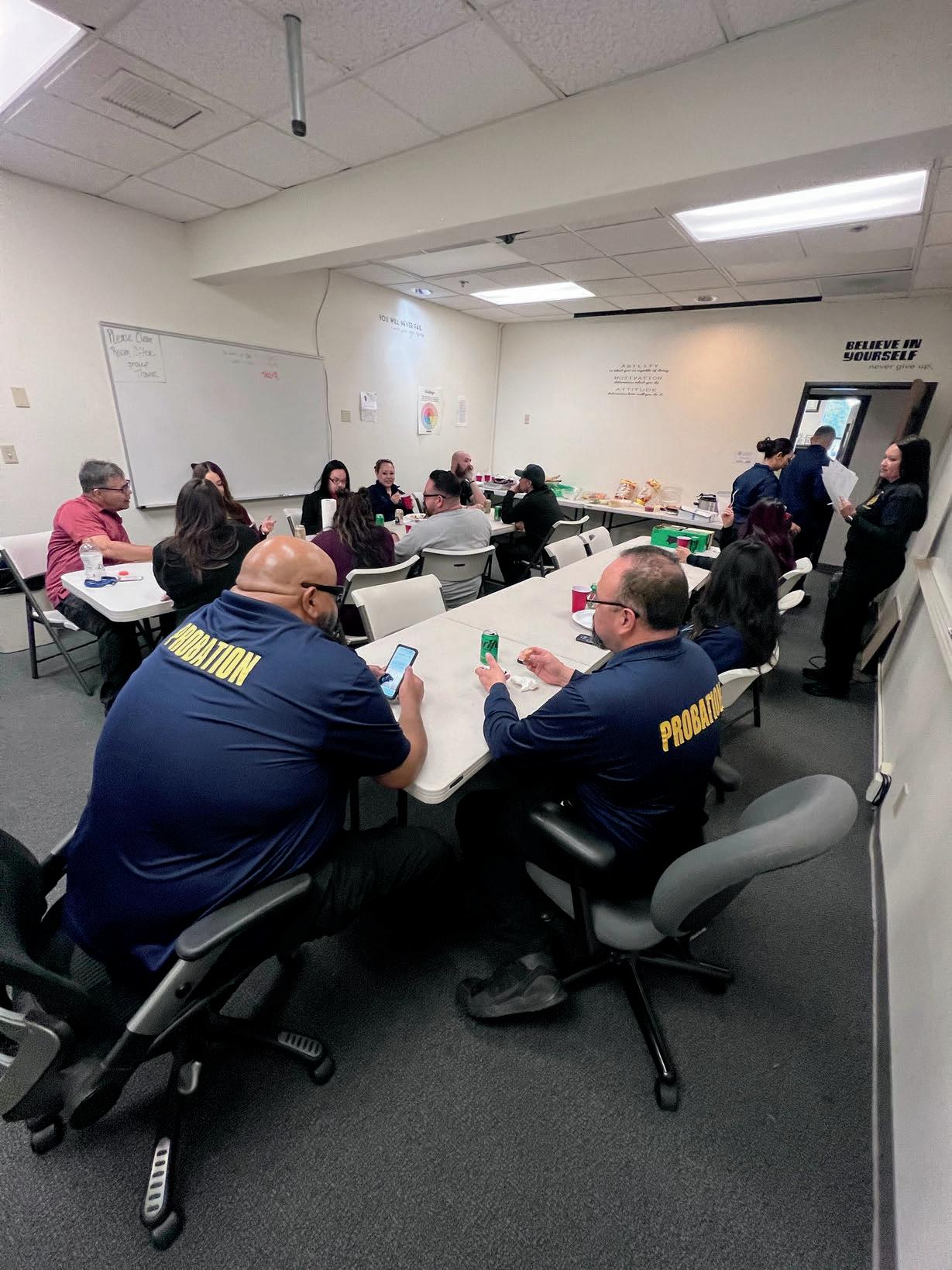
on individualized case management and control plans to ensure community and victim safety. The guiding principle of this model emphasizes prioritizing the well-being of victims, their families, and the community in managing clients who have committed sex offenses. A multi-disciplinary case management team convenes monthly to oversee each client's progress. Their activities encompass three (3) interrelated, mutually enhancing activities. These include community supervision approaches that address the specific offending behaviors of each client, specialized sex offender treatment, and polygraph examinations to assess pre-conviction sexual behaviors and compliance with probation terms and conditions.
In July 2019, Santa Barbara County was selected as one of the six California counties to initiate a three-year pilot program under AB 372. This legislation introduced changes to the local Batterers' Intervention Programs (BIP) and added Section 1203.099 to the California Penal Code. An extension of AB 372 through June 30, 2026 was approved on July 21, 2023. The Probation Department utilizes the Specialized Treatment for Optimized Programming (STOP) curriculum, which offers tailored versions for men, women, and Spanish-speaking clients
Within the department, the Adult Supervision Unit provides specialized supervision for clients who have committed Domestic Violence (DV) offenses and are assessed as high risk for reoffending. To assess risk and needs, the department employs the COMPAS risk and needs assessment tool, along with the Ontario Domestic Assault Risk Assessment (ODARA) DPOs assigned to DV caseloads undergo specialized training and certification to conduct ODARA assessments, which help determine the likelihood of future domestic violence incidents.
Clients identified as high risk of reoffending must complete a 26-week BIP curriculum in addition to programming that addresses their criminogenic needs. Clients identified as low-risk are required to complete a 16-week online program
Currently, Domestic Violence Reviews (DVRs) are scheduled on an as-needed basis by the Probation Department or District Attorney's Office for clients who are not in compliance. The DVR team consists of representatives from the Probation Department, the Public Defender's Office, the District Attorney's Office, and the program provider. This team attends court hearings to provide updates on the client's progress during probation and treatment. DPOs conduct home visits, hold meetings with clients at the office, and maintain communication with victims through the DA's Victim-Witness Assistance Program.
The Probation Department, with the aid of grant funding from the Office of Traffic Safety (OTS), assigns a dedicated DPO to supervise a caseload of clients convicted of Driving Under the Influence (DUI). This specialized caseload, known as DUI Intensive Supervision, operates out of Santa Maria. Clients on this caseload receive additional field supervision and office contacts, participate in DUI program verification activities, undergo searches, are subject to routine alcohol testing, and the use of SCRAM. Clients on the DUI Intensive Supervision caseload are also involved in regularly scheduled Court reviews through a DUI review calendar This collaborative process entails increased scrutiny by the Court and implements graduated sanctions for clients who fail to comply with program requirements. This approach aims to ensure accountability and promote sobriety and adherence among the clients.
The Santa Barbara County Familiar Faces Team consists of a Supervising Probation Officer, Deputy Probation Officer, Public Defender Holistic Advocate, Behavioral Wellness Recovery Assistant, Behavioral Wellness Practitioner and Behavioral Wellness Case Worker, all of whom work collaboratively to engage and assist high utilizers of the county jail, those who

generate a high number of local law enforcement calls for service within the city of Santa Barbara, and/or who are frequently placed on psychiatric holds or generate crisis calls. The mission of the Familiar Faces Team is to conduct daily outreach and engagement to facilitate the expedited identification, assessment, and linkage of Familiar Faces clients to supportive services within the City of Santa Barbara and surrounding areas. This includes building rapport and relationships based on trust, with the goal of implementing coordinated intervention plans for the priority population. In addition, the team helps broker access to services and community supports through intensive engagement and a “ warm hand-off” approach and ensure that each client is tracked throughout the entire engagement process for continuity of care, ensuring the case is not passed through until the individual has been contacted by the service provider and enrolled in services, as necessary.

The Probation Department operates the Susan J. Gionfriddo Juvenile Justice Center (JJC) located in Santa Maria. The JJC includes an intake and release area administration offices a medical clinic, a Master Control Room units. Each of the newer units have two (
dining room, dayroom, and an outdoor recreation area. The MCR, staffed by an Administrative Office Professional (AOP), visually monitors over 95 cameras and provides keyless entry and exit within the interior and exterior of the facility. The primary purpose of the JJC is to provide a safe and secure environment while also providing meaningful interventions, treatment, and educational opportunities to the youth being housed within the facility.
If a youth is detained, a court hearing must be held within a specific time frame to determine if continued detention is necessary to keep the youth and the community safe. The Deputy Probation Officer (DPO) will make a recommendation for continued detention if the youth is a risk to themselves, a risk to the community, or likely to flee the jurisdiction of the Court. Following the conclusion of the court process, the youth may remain at the JJC until the Court makes specific decisions in the youth’s case.
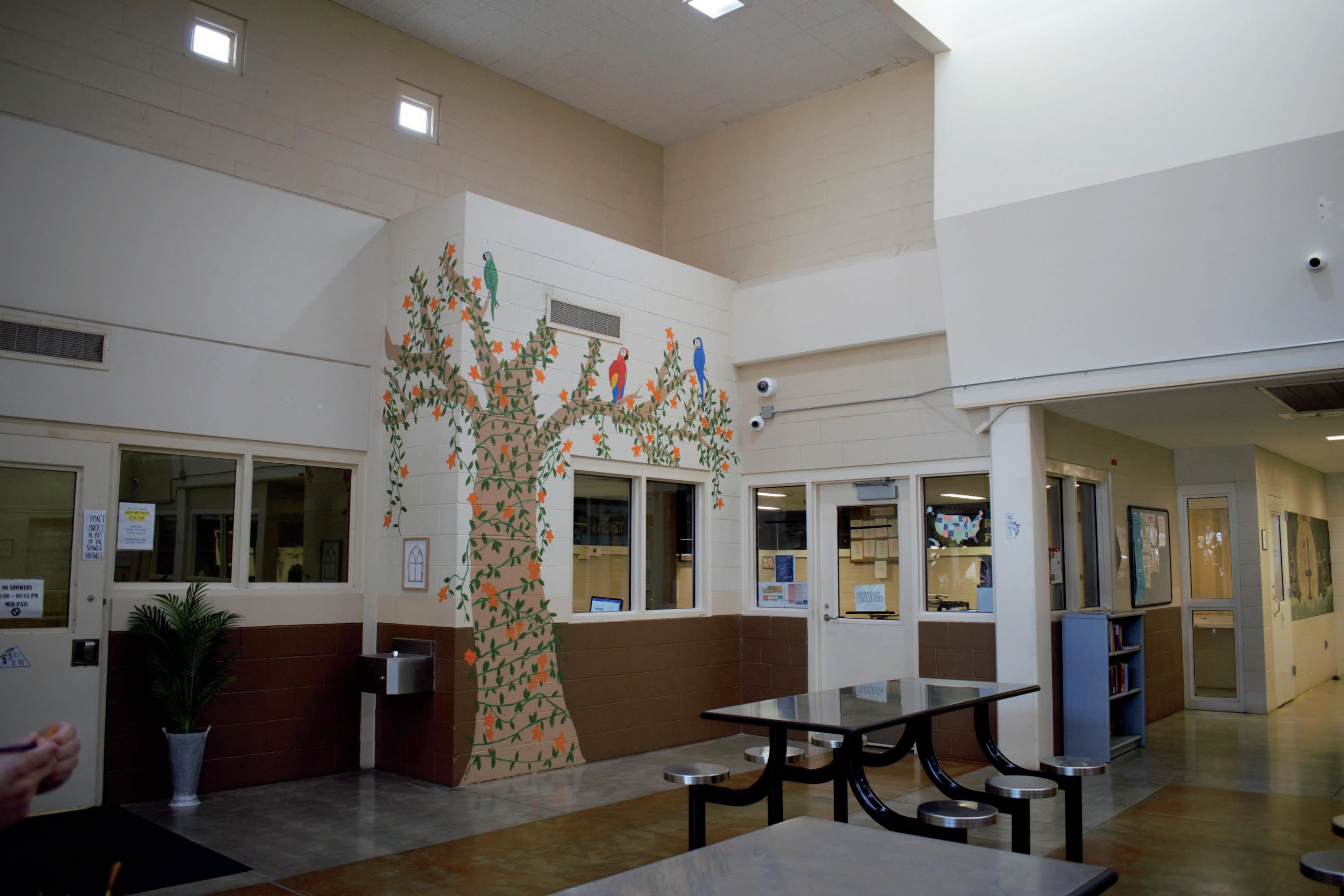
Youth at the JJC are screened at intake by Probation staff. Behavioral Wellness (BWell) and medical personnel onsite address critical mental or physical health concerns All youth are further assessed by BWell staff and provided a physical examination by medical staff within 96 hours.
In January 2020, one unit was converted into the Trust Unit, an open, home-like environment within the facility. There are four (4) main principles of the unit: Follow Instructions, Be Respectful, Meet Expectations, and Be Responsible. From 7:30 AM - 9:00 PM, youth move freely within the unit and yard. The dayroom simulates a living room with carpet and sofas positioned around televisions. A TV equipped with a DVD player and another with a PlayStation 4 are available to the youth In addition to a more comfortable environment, youth cultivate a sense of independence, learn time management, and improve personal responsibility for their hygiene, laundry and overall cleanliness. Youth also build self-esteem, develop positive communication and team building skills, and work

The Juvenile Justice Center (JJC) has earned accreditation from the National Commission on Correctional Health Care (NCCHC) by demonstrating compliance with NCCHC’s Standards for Health Services in Juvenile Detention and Confinement Facilities, the most respected standards in correctional health care. towards creating positive life goals. The Santa Barbara County Education Office (SBCEO) provides five (5) 50-minute periods of classroom instruction five (5) days per week, in addition to an initial educational assessment, and special education and resource instruction. Vocational services are also offered by way of the Career Technical Education (CTE) lab in one of the classrooms in the JJC. An electronic key tracking system was added in 2024. There are future plans to create an in-custody program unit and to rejuvenate the original three units.
In anticipation of Juvenile Justice Realignment in 2021, a Secure Track program was developed to house long-term youth committed by the Court, which may include youth ages 14-23, and up to age 25 depending on the length of the disposition ordered by the Juvenile Court. This program uses a trauma informed case-based approach and revolves around a strength-based, asset-based and the Positive Youth Development (PYD) approach. Other programs offered at the JJC include Moral Reconation Therapy (MRT) and Seeking Safety MRT is an evidence-based, cognitive behavioral treatment program focused on substance use that targets recidivism reduction and is designed to facilitate the development of higher stages of moral reasoning. MRT meets weekly with additional homework and reading sessions by the participants. MRT is designed to be for open-ended groups and can be completed in 20-30 sessions. Seeking Safety is an evidence-based treatment intervention that provides coping skills to help youth
attain safety from trauma and/or substance use. This program directly addresses both trauma and addiction without requiring youth to delve into the trauma narrative. Seeking Safety offers 25 topics, each representing a safe coping skill. The ARISE program, a gang prevention/intervention program for youth ages 13-25, meets once a week for one (1) hour. The curriculum is intended for at-risk youth and youth already involved with gangs.
The youth within the JJC are offered the opportunity to earn college credits while they are still enrolled in high school and also upon graduation. Youth are provided support by the Rising Scholars organizations, which is affiliated with Allan Hancock College. The Rising Scholars Organization is comprised of members who have been formally incarcerated or impacted in some way by the justice system. The members of Rising Scholars provide a unique and extremely valuable perspective on what struggles and challenges youth may encounter during their quest for high education and leaving the facility after their release. The Rising Scholars members offer not only educational assistance, but also mentorship to the youth within the JJC.
Youth at the JJC participate in supervised recreational and PYD activities and educational programs. To support these activities, a large play yard has been converted to reflect a green space where youth can have the opportunity to enjoy the fresh air, visit with family and participate in extracurricular activities. Youth are also afforded the opportunity to participate in family counseling and evidence-based cognitive behavioral programs and other individualized services provided by BWell.
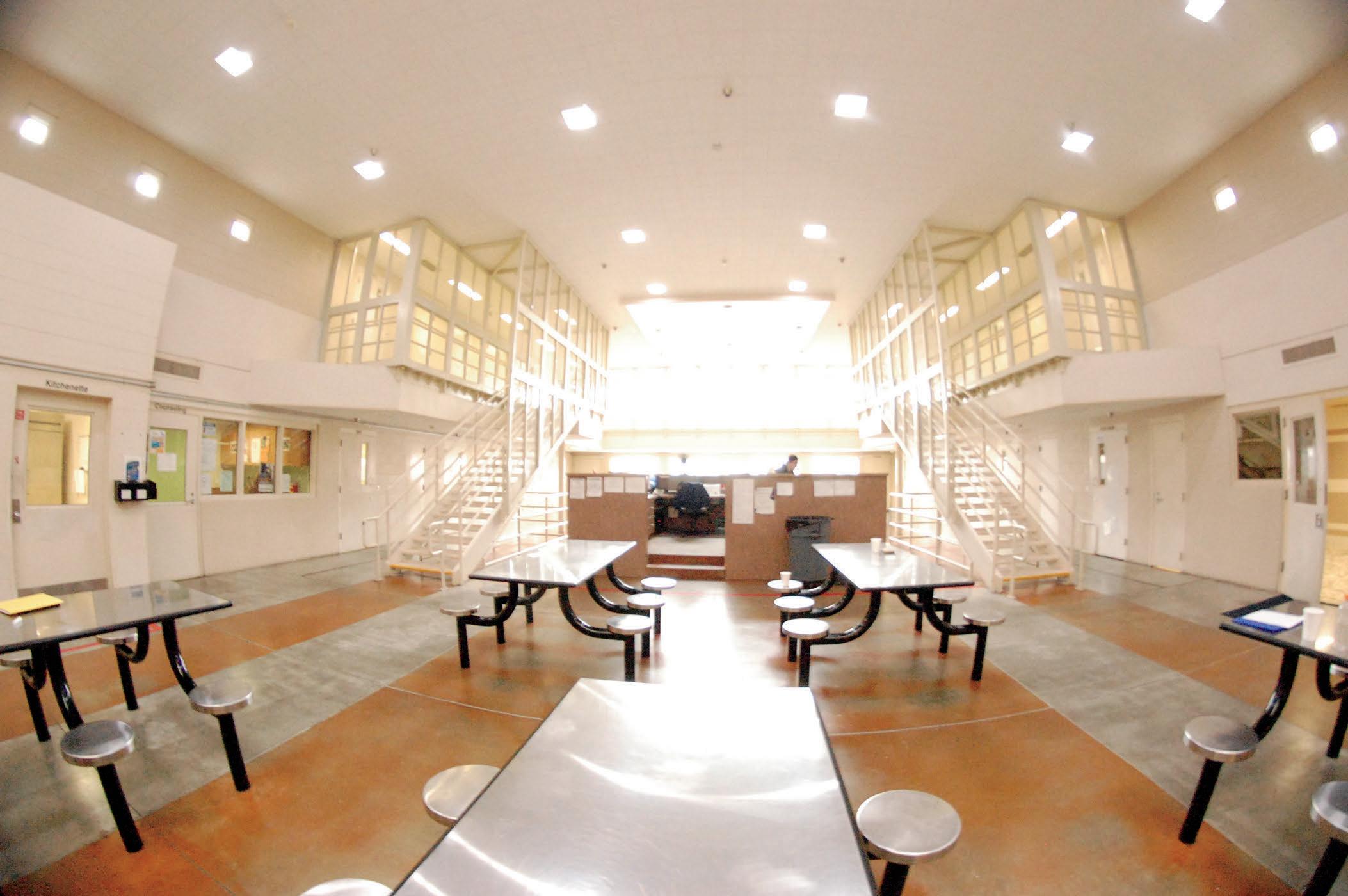
Regular visitation is available for youth with their parents, DPO, and attorneys, as well as access to voluntary religious services. The primary goals are family reunification and successful reintegration into the community.
As part of the JJC release decision-making process, or at the direction of the Juvenile Court, eligible youth may be placed in the Home Supervision Program, a community-based alternative to detention. The program provides structure and supervision to youth who might otherwise remain at the JJC. The Home Supervision Program offers the County a cost-effective alternative to housing youth in a secure environment. It allows youth to remain with their families with additional supervision and the opportunity to take advantage of community interventions and programs.



In line with current research, the Probation Department strives to intervene on referred matters at the lowest level possible. Diversion out of the criminal justice system is the first option for offenses not statutorily required to be referred to the District Attorney’s Office (DA) Diversion may include directly closing low level matters, discussions with parents about the youth’s decision making, referrals to the Youth Empowerment Services (YES) program, Cannabis Education, and/or community service work hours, as required by code
For youth who are not eligible for diversion, but who do not yet require formal court intervention, additional attempts to address behaviors are made. These include the Tara Haaland-Ford Diversionary Restorative Justice Program, the Fighting Back Santa Maria Valley Restorative Justice Program, or meeting with a Probation Officer to determine other interventions that might meet a youth’s needs A grant of informal probation can be initiated, which requires the youth and parent to sign a six-month contract where the youth would be required to complete specific terms such as community service work, counseling, evidence-based programming, and/or restitution.
Intake is the initial step in the law enforcement referral process for youth. Referrals are made through an application and affidavit, which together allege that a youth violated the law. These violations are those that would be a crime if committed by an adult. The Probation Department reviews referrals to determine which can be handled informally through diversion options as noted above, and which require more formal intervention.
A Senior (Sr.) DPO assigned to Intake will refer matters directly to the DA when required by law. These mandatory referrals are often for serious offenses and are required for youth who have previously been on probation or if there is a restitution claim in excess of $5,000. When appropriate, Probation requests the DA return mandatory referrals to be handled informally, when mitigating circumstances exist, or when it appears the matter can be addressed without Court intervention. In most cases, referrals are received for youth who remain in the community and reside at home. In other cases,
In 2020, the Probation Department launched the Whole Youth Project (WYP), a two-year initiative in partnership with Ceres Research Policy The initiative helps agencies collect data on every young person’s sexual orientation, gender identity, and gender expression (SOGIE) to effectively affirm young people’s many identities Subsequently, Pacific Pride, a local community-based organization (CBO), facilitated training to expand staff knowledge of appropriate terminology and guide staff on how to appropriately ask questions related to a youth’s SOGIE. A recording of this training is available for new staff to view, and review of the video is a requirement in all contracts with CBOs for provision of services to juveniles on probation beginning in 2024.

In 2024, One Circle provided “Mitigating Gender and Racial Bias” training to all Probation staff. SOGIE was a significant part of this training. These trainings, along with data from Probation’s case management system, continue to be analyzed to improve services, community outreach, and a continuum of care that affirms lesbian, gay, bisexual, questioning, gender nonconforming and transgender (LGBQ/GNCT) youth
referrals are received for youth who are taken into custody at the time of the offense based on the seriousness of the crime and the safety risk the youth poses to either themselves or to others. In these situations, DPOs evaluate the need for a youth to remain in custody, looking to release the youth back into the community pending further investigation or court hearings when determined safety concerns can be appropriately mitigated When the risk to a youth or others is high, a youth may remain detained pending a court hearing where a judge will review the circumstances and rule on further detention after hearing from involved parties. Probation seeks to limit the use of detention at the Juvenile Justice Center to only the highest risk cases and only for the time necessary to address safety concerns. Some youth are released on forms of home supervision, including the use of Global Positioning System (GPS) monitoring, pending further court proceedings, and per statute, youth receive custody credits for days spent under electronic supervision.
When the DA files a §602 Welfare and Institutions petition, the case proceeds through the Juvenile Court in a manner similar to adult court proceedings. In some cases, the Court may find the youth is eligible and appropriate for a lower level of intervention despite the filing of a petition. In these cases, the Court can order a grant of informal
Welfare and Institutions Code (W&IC) sections govern the operation of the juvenile court law and subsequently juvenile probation activities.
For youth who remain detained, referrals are handled expeditiously, and youth are brought before a judge within specific legal timeframes. An evidence-based risk and needs assessment instrument is used to identify youth at the highest risk for reoffending as well as to guide decision-making on appropriate case planning their suitability to have their needs met within jurisdictional timelines and their fitness for rehabilitation using interventions available through the juvenile system. In these rare occasions, DPOs will prepare Transfer Reports that review mandatory considerations
probation of deferred entry of judgment To help the Court determine which grant of probation is most appropriate, DPOs prepare reports that include a summary of the offense, the youth and family’s social history, concerned party statements, and a recommendation for the appropriate disposition and associated services For specified serious offenses, the Juvenile Court may evaluate a youth’s case for being transferred to adult criminal court, specifically evaluating
for the Court, though the lens the decision is viewed from assumes the juvenile will be retained in the juvenile system outside of factors being found applicable to transfer them to the adult court system. A youth may also be placed on formal probation with Artwork by a County of Santa Barbara Probation youth certain terms and conditions and be allowed to remain in their home when they are determined to not be eligible or suitable for lesser grants of probation. These youth may also be detained in a juvenile facility or placed in foster care program, initially upon being placed on probation, or at a later time, based on subsequent behavior and changing circumstances.

Youth who are placed on probation are supervised by DPOs in the community from an office location closest to their residence. DPOs collaborate with youth, family members, educators, treatment providers, and other persons or agencies to develop the youth’s case plan which targets a youth’s greatest risk and needs factors using the Risk-Needs-Responsivity (RNR) Model. This evidence-based approach to supervision considers a youth’s assessed risk and their greatest criminogenic factors, and matches them with the most appropriate interventions based on their characteristics and individual learning style. It also considers their areas of strengths and identifies their support networks in balance with assigned interventions to address criminogenic needs. To support youth in meeting case plan goals, DPOs contact youth at their homes, schools, offices, programs, and in the community. DPOs also contact youth at the Juvenile Justice Center (JJC). DPOs regularly meet with parents, guardians, and other identified supports in the youth’s life, and include them in case plan goals. Further, DPOs are trained in conducting Child Family Team Meetings (CFTMs) and the Probation Department shares a contract with the Department of Social Services with a community-based organization to facilitate CFTMs which allow for the youth and family to have a voice in the case plan. CFTMs also provide an opportunity to discuss the youth’s progress or concerns in a treatment setting to address their needs. Further, CFTMs are required when a youth is removed from their home and placed in foster
care, at various intervals while in foster care, and prior to their return to the community to support them in each stage of the process. Youth are required to obey the orders of the Court and the directions of their assigned DPO. They may be required to submit to a search of their person and property, do drug and alcohol testing, go to specific programming, abide by a curfew, and repay losses incurred by their victims. Probation terms are intended to keep youth from engaging in illegal or high-risk behaviors and to encourage pro-social behavior. When youth violate the terms and conditions, DPOs utilize a Violation Matrix to determine the most appropriate intervention When those are unsuccessful, or when safety is of concern, youth can be returned to court for violation proceedings. Youth may also be required to pay restitution to victims or complete community service work hours. Conversely, when youth excel in meeting case plan goals, Probation staff utilize an Incentives Matrix to provide positive reinforcements to youth.

In April 2024, during Child Abuse Prevention month, Probation partnered with Child Welfare Services, Public Health, Behavior Wellness, Santa Barbara City College, and Allan Hancock College for three regional Family Engagement events The events included tables hosted by local community-based organizations which highlighted available programs, offering a holistic approach to meet families’ needs Over 500 families attended the three events, 306 Narcan kits were distributed, and over 90 agencies participated in tabling. The agencies involved in these events are committed to facilitating similar events in the future.
Youth at risk of entering and returning from foster care may be referred to the Wraparound Program. The program is open to youth served by Probation and Child Welfare Services. Probation uses the program to provide services to families experiencing difficulties and dysfunction in the home. The objective is to offer intense home-based services to stabilize a family and prevent a youth from continuing delinquent behavior or entering foster care. The program offers a combination of parent peer support, counseling, and programming delivered in a strength-based approach. As part of their aftercare plan, youth placed into foster care may receive wraparound services upon reunification with their families. CFTMs are held incrementally, and often weekly to support youth and families in reaching goals which in turn help youth remain in their homes.
In some cases, youth on probation may be removed from their home and placed into a foster care program because of serious behavior or mental health issues, and/or serious safety issues. Foster care can include placement with a relative or non-relative, an independent living arrangement, or in a Short-Term Residential Therapeutic Program (STRTP) The goal is to limit a youth’s exposure to foster care, and provide a high level of therapy and services in a short period, to stabilize a youth so they may return home or transition to a lower level of care. Wraparound may be used to support a youth and resource (foster) family for a youth in relative care or to ensure a successful transition from congregate care to the home. Youth placed in foster care must meet specified criteria for care, demonstrating their mental health needs meet medical necessity for this level of care In cases where removal from their homes appears necessary, cases

are reviewed by the Interagency Placement Committee (IPC), composed of Probation, Behavioral Wellness (BWell), Child Welfare Services, the Santa Barbara County Office of Education, Tri Counties Regional Center, and a local foster home agency to determine the need for out-of-home placement, as well as the appropriate setting and services. BWell also completes a Qualified Assessment for youth being placed in an STRTP to ensure this is the appropriate level of care and to outline the youth’s needs to be met in the program.
Some probation foster youth transition to independent living arrangements when they turn 18 years old and still receive services and supervision from a DPO, but are then considered non-minor dependents, rather than wards of the Court. Youth may also be placed in a local shelter care program if they are experiencing a crisis that does not require formal removal from the home. For a short period, they may stabilize in the program and receive needed support to assist them in returning home. This includes referrals to other community programs and engaging parents and caregivers.
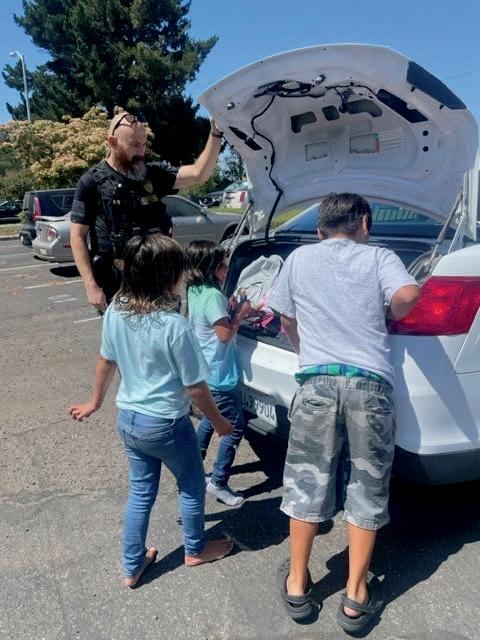

Probation conducts two juvenile wellness operations annually. The first occurs prior to the new school year. Officers visit families in their homes to ensure youth and their siblings have school supplies and families have support in enrolling youth. Referrals to services are provided The second operation occurs prior to the December holidays and provides families with food, toys for younger children in the home, and gifts for youth on probation to ensure families feel supported and celebrated.
Probation contracts with several local community-based organizations (CBOs) to provide specific treatment interventions for supervised youth as well as other services tailored toward their individual needs. Programs include those with a specific evidencebased curriculum such as Seeking Safety and Joven Noble, as well as other programs such as mentoring and targeted interventions that are more individualized There are also now re-entry navigators who are now working in the JJC. These navigators work with to youth to prepare for their return to the community and then support them through their re-entry. Probation also operates a Memorandum of Understanding with the Department of Social Services (DSS) regarding utilization of a contract DSS has established for the provision of parent partners for parents with youth in the juvenile justice system. This service support parents in understanding the court process and in learning how to best partner with Probation in the best interest of the youth and their rehabilitation. Youth and families participate in these and other referred programs at no cost to them or their families.

A juvenile record may be sealed by the Juvenile Court when a youth’s case is closed successfully or when a youth applies to have it sealed. For most youth, this occurs when the case is closed or probation is terminated. Specified violent or aggravated offenses may preclude a record from being sealed if the youth is under the age of 18. There are no fees for the sealing of a juvenile record. All agencies maintaining any record of the youth must destroy or delete information pertaining to that youth when the Court orders the case sealed, including cases that were informal in nature




